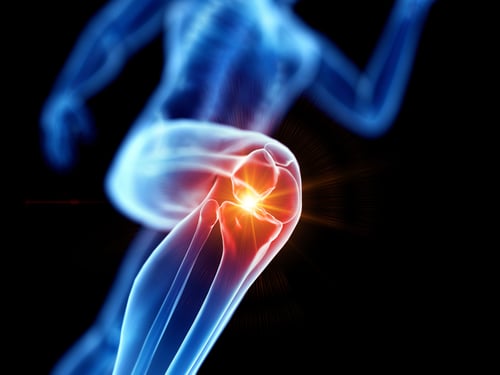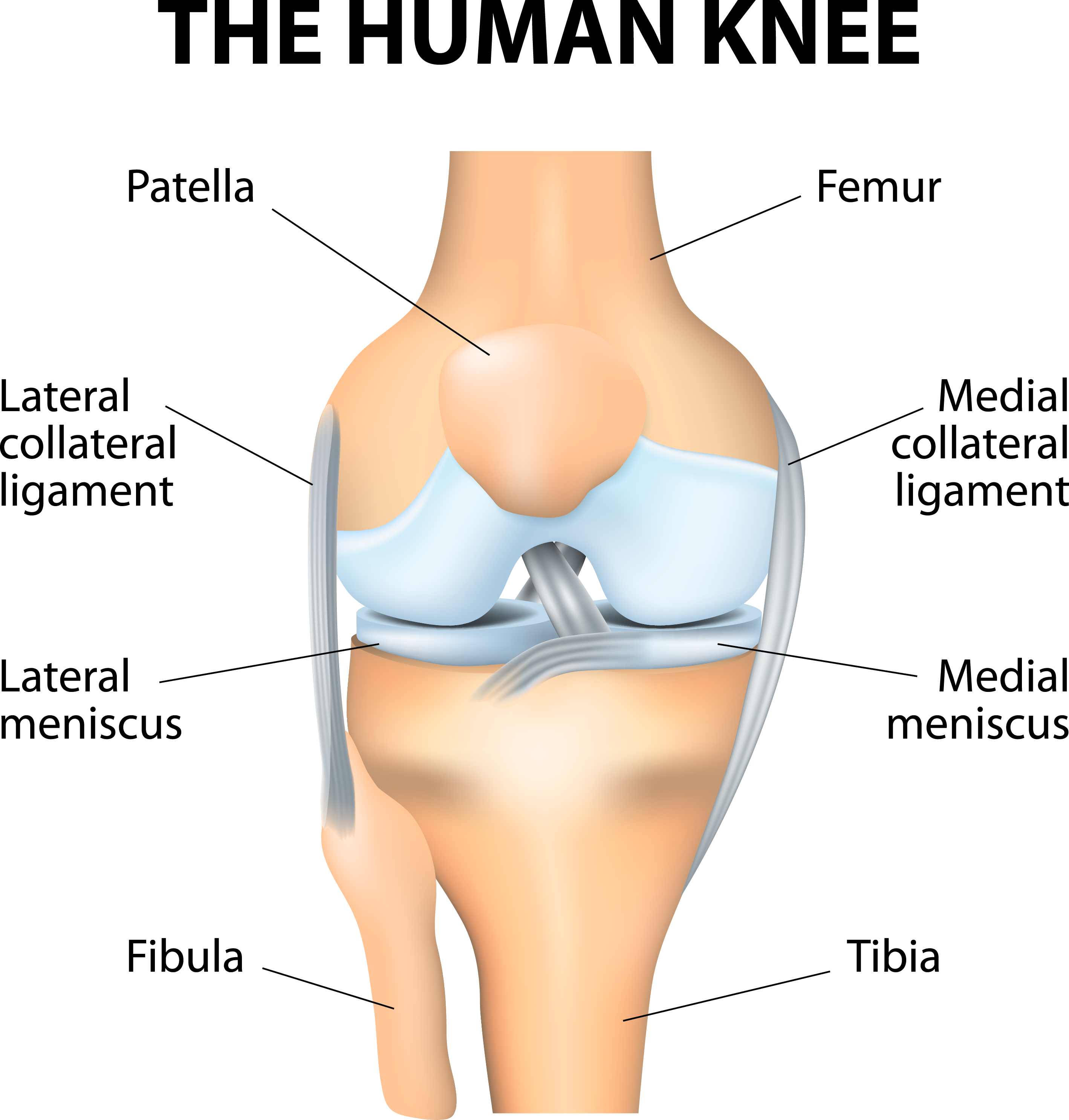Bad Knees? How To Exercise with Unbearable Knee Pain

One of the most common complaints I hear from clients is knee pain. Someone will tell me they can’t exercise because they have bad knees, or I will hear they don’t want to exercise for fear of hurting their knees. Knee pain is something that affects millions of people in the United States. According to a study published in American Family Physician, “Knee pain affects approximately 25% of adults, and its prevalence has increased almost 65% over the past 20 years, accounting for nearly 4 million primary care visits annually.”. There are many reasons why one could be suffering from knee pain and it can happen at any age.
The Knee Joint
The knee is the largest joint in the body. It allows your leg to bend and straighten by connecting the upper leg bone (femur) to the two lower leg bones (the tibia and fibula). There are two pieces of cartilage (the medial and lateral meniscus) that sit and act as cushions between these bones. (There is also additional cartilage that covers the long bones that is different than the meniscus.) Numerous ligaments act as stabilizers in your knee and tendons connect the bones to the muscles. Your kneecap (patella) sits on the front of your knee and moves up and down when you bend and straighten your knee
 .
.
Two groups of muscles are the main support to the knees. One are the hamstrings, which are the muscles on the back of the thigh. They run from the hip to just below the knee and work to bend the knee. The other are the quadriceps, which are the four muscles on front of the thigh that run from the hip to the knee and straighten the knee from a bent position. Your hip muscles can also affect your knee, as they control the way your knee moves and work together with the other muscles connected to your knee.
What Are Some Causes of Knee Pain?
A common cause of knee pain can be from an imbalance in the strength around the knee. For example, “Runner’s Knee” (patellofemoral pain syndrome) is pain right behind and around the knee cap. Runner’s knee isn’t a structural problem (like a torn meniscus), the issue lies in how your muscles function. It is most often a result of abnormal mechanics caused by muscle weakness and/or tightness in the legs or core that forces the patella to bump against the femoral groove causing pain. Often our quadriceps are stronger than the hip muscles and/or hamstrings. Strength training for the posterior hip muscles, like the gluteus medius will help correct this incorrect movement of the kneecap. Tight muscles can also be a cause of misalignment. Static stretching after exercise and foam rolling can help relieve tight muscles.
This doesn’t just happen in runners. Many people have an imbalance in the strength around the knee which causes the knee to be unstable. This can be caused by our sedentary lifestyles. When we spend the majority of the time sitting, our hips, glutes and hamstrings are tight and not as strong as our quadriceps.
Hip or foot pain can change the way you walk. This altered gait can place more stress on your knee joint. In some cases this can cause knee pain. Identifying the cause of the hip or foot pain is important to realign your gait and subsequently ease the additional joint pain. Sometimes a pair of shoes can change your posture and walk. Making sure your shoes have the support you need is important to prevent any injuries or ease existing pain.
Excess body weight can also put a lot of pressure on the knees. A study showed that each pound of weight loss can reduce the load on the knee joint by 4 pounds. Lose 10 pounds, and that’s 40 fewer pounds per step that your knees must support. Less pressure means less wear and tear on the knees.
Inflammation is another cause of knee pain and can be due to a variety of reasons. Being overweight may increase inflammation in the body that can lead to joint pain. Losing weight, a healthy diet, reduction of stress and good sleep are all things that can reduce this inflammatory response. Inflammation is also a symptom of arthritis.
There are many different types of arthritis. The three types that most often occur in your knees are Osteoarthritis, Rheumatoid Arthritis and Post-Injury Arthritis. Osteoarthritis is a progressive condition that slowly wears away joint cartilage. Rheumatoid arthritis is an inflammatory condition that can strike at any age. Another type of arthritis can develop following an injury to the knee.
Knee injuries can include torn meniscus or ruptured ligaments, inflamed tendons or torn cartilage. Injuries can be caused by many different reasons; including sports injuries, falls or other accidents.
Should You Exercise with Knee Pain?
Now that you have a bigger picture of how it all works together, it should make sense that having strong muscles and bones to support the knees can help, and may eliminate or prevent pain. By building strong muscles, you can reduce knee pain and stress and help your knee joint better absorb shock. Strengthening exercises involve developing stronger muscles in your quadriceps, hips, and hamstring. Having strong muscles in place can take some of the pressure off your knees.
A common misconception is that exercises can harm your knee joints by placing excess pressure on them, especially in high impact activities such as running or high impact exercises. A study in the National Institutes of Health shows that arthritis in the knees is not more common in those that run. A report by the American College of Sports Medicine (ACSM) provides strong evidence that exercise is, in fact, good for the knees. The findings concluded that exercise actually helps improve the cartilage in between joints instead of breaking it down.
Keeping moving with low impact activities and strength training will help arthritis pain. Swimming, water aerobics, stationary bicycles and low impact aerobics are all good examples of low impact activities appropriate for those with arthritis. Movement is lotion for the joints.
Example Exercises
Here are a few exercises to help strengthen the muscles that support the knee. I would recommend starting with 10 repetitions of each. Only increase that number when you can perform them easily, without pain or difficultly. Complete a 5 minute warm up, a walk or stationary bike, prior to completing these exercises.
Lateral Band Walks
Place a resistance band around your ankles. Come into a half-squat position, with core tight and glutes engaged. Without letting your knees cave in, and keeping your weight in your heels, step out sideways with one foot, and slowly follow with the other foot. (You can add a second resistance band above your knee for additional challenge.)
Forward/Backward Band Walks
Place a resistance band around your ankles. Come into a half-squat position, with core tight and glutes engaged. Step forward at a 45-degree angle with one foot, and follow with other foot. Repeat on the other side.
For backward, take a step backwards at a 45-degree angle.
Wall Squats
Stand up straight with your back to a wall and your feet parallel, about two feet away from the wall, spread hip-width. Slide down the wall slowly until you are just about in a sitting position. Hold that position for up to 10 seconds and then slowly slide back up. Don't allow your knees to overextend in front of your toes.
Hamstring Curls
Lie flat on your stomach. Slowly bring your heels as close to your butt as you can, and hold that position for a few seconds then release and extend your legs. You can also do this exercise standing while you hold onto a chair and lift one leg at a time.
Hip Raise or Bridge
Lay on your back on the floor. Bend knees keeping feet on the floor. Heels should be close to the butt. Pushing off with the heels, squeeze your gluteal muscles and lift the hips towards the ceiling and slowly lower your hips back to the floor rolling your spine down one vertebrae at a time.
Calf Raises
Simply stand with your heels hanging over the edge of a stair and rise up onto your toes to perform calf raises.
There are many ways to strengthen the muscles that support the knee. Exercise selection depends on your fitness level and your specific knee issue. Consulting with a physician, physical therapist or personal trainer can help determine what is appropriate for you. The best thing you can do for existing knee pain, and to prevent knee pain, is to strengthen the muscles that support your knee and keep them flexible. Don’t let knee pain keep you sidelined, keep moving!
Topics: LivRite News


